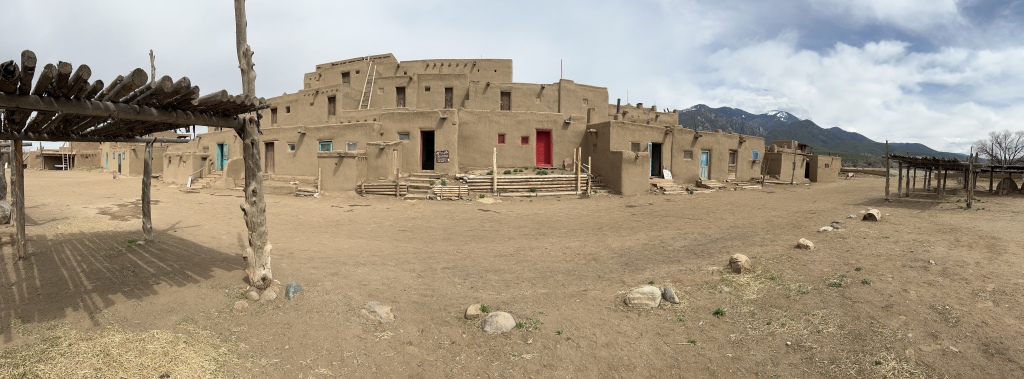
Taos Pueblo has been continuously occupied for over 1,000 years—perhaps far longer—, much older than European settlements, and it is a World Heritage Site. Archaeologists have not extensively excavated the area—because the Red Willow people are still living there—, but there is evidence of trade with Mesa Verde and other early Native American settlements dating back many centuries. The multistory building above is home to many families, and folks on the upper floors climb ladders to access their apartments. While modern doors and windows have been added, the families, community and tribal government preserve the village in its original form, using mostly traditional building materials and avoiding electricity and plumbing anywhere within the village.
The pueblo sits below the Sangre de Cristo Mountains, a significant portion of which were returned to the community by President Nixon, including the Blue Lake and the headwaters of the Red Willow Creek. The creek runs through the middle of the village, is the sole source of water and flows into the Rio Grande. The Rio Grande Gorge southwest of Taos is strikingly beautiful, as are the Palisades near Eagle’s Nest northeast. The pueblos in this area are at the crossroads of ancient trading routes from coast to coast and to Central America.
Taos means Red Willow in the Tiwa language, and it is a town in an area crowded with history. Coronado arrived in 1540, and the Spanish built the first San Geronimo Church in 1620. When their Native dances, songs and worship were prohibited, the people here joined the Pueblo Revolt, which destroyed this any many other churches and forced the Spanish to retreat to what is now Mexico. The Spanish eventually reconquered the area and rebuilt the church. After the Spanish were forced to cede their territory to end the Spanish American War, the US Cavalry eventually was sent to subdue the people, who took refuge in the church. There were no survivors of the artillery bombardment, and the old church grounds are now a cemetery. The new San Geronimo Church contains a statue of the Virgin Mary from the old church, and the villagers practice both their indigenous Nature-focused religion and Catholicism with indigenous elements.
The locals give tours, sell handicrafts and run bakeries and cafes. Al’Thloo’s (grandmother’s) Cafe serves excellent Piñon Coffee and a Taos Pueblo Taco on freshly baked Frybread. The proprietress explained that the creek is currently near record flooding, due to the unnatural heat this Spring, and she informed me about the havoc that the Climate Crisis is having on snowpack, wildfires, drought, irrigation, crops and ranching. Her husband fought in WWII, and her family has been involved in supporting Native American causes for decades from here to Standing Rock. I wish more people were as clear-eyed and passionate as she is.
Pingback: The Old Spanish Trails | Zero Carbon Travel
Pingback: Continental Divide National Scenic Trail | Zero Carbon Travel
Pingback: Northern Rio Grande and Sangre de Cristo National Heritage Areas | Zero Carbon Travel